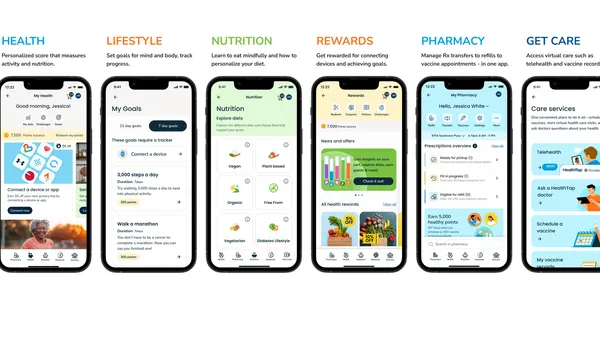On the heels of high consumer demand for store brands, grocers are setting ambitious targets for their private brands.
One of the boldest goals includes bumping up the current average dollar share of 18.2% to 22.6% in the next two years — a gain of about 24%, according to the second installment of the Food Industry Association’s (FMI) Power of Private Brands report this year.
As grocers pursue private brand acceleration, FMI’s findings indicate they are not always on the same page with their suppliers, consumers and internal teams in certain areas, which could impact the growth trajectories of their store brands.
The new report is based on the trade group’s private brand industry survey and companion interviews with food industry executives. Fifty-seven industry executives responded to the survey between May 10 and June 10.
Here are some of the main cracks concerning private brands noted in FMI’s report.
1. Walking the walk
Sometimes, the opportunities grocers say they are eyeing aren’t the ones they are actually pursuing.
Survey respondents almost evenly divided their interest in where they see the biggest avenues for private brands regarding meals and cooking: 47% each selected retail foodservice or heat-and-eat, center store and cross-marketing meal marketing, while 44% choose product promotions in recipes.
When FMI asked which of those approaches respondents are pursuing, 78% said center store. “[Only] about one-third pointed to the other categories,” the report noted, adding that the total-store vision still needs further execution in other areas in order to come to fruition.
In another example, half of the respondents said they see opportunities to enhance branding for fresh items (50%) and to increase fresh marketing for private brands (50%), yet only 14% and 37%, respectively, said they are currently doing so.
FMI’s findings indicate grocers need to be mindful of what they identify as growth strategies and where they are investing time, resources and effort as they look to close opportunity gaps.
2. Room to improve e-commerce
Grocers still don’t fully seem to have their finger on the pulse when it comes to bringing their private brands online.
Only 60% of surveyed retailers said their private brand assortments are on their e-commerce platforms, FMI found. Grocers are lagging in this area partly due to supply chain issues impacting availability, challenges getting accurate pictures to use and obstacles with selling certain products like soup or food service items, which consumers buy by weight or prefer to purchase in-person, the trade group noted.

Still, FMI said expanding the percentage of SKUs available online is a “big opportunity” for private brands and also encouraged grocers to consider offering online-only SKUs to unlock new ways to entice shoppers.
Making search functionality prioritize private brands, offering compelling product images and adding digital tags on products to highlight specific attributes are top e-commerce strategies, FMI found.
Manufacturers already seem to place more value on certain e-commerce features, such as seeing a need for tagging specific attributes (71%) and boosting descriptive marketing tied to attributes (43%), compared to 50% and 36%, respectively, of retailers who said the same.
3. Different takes on growth trajectories
Across all retail outlets. U.S. store brand share of total dollar sales is roughly 17% annually, according to IRI data cited by FMI. For both short- and long-term growth expectations, manufacturers were more aggressive than retailers in their predictions of how high private brand share can reach, FMI found.
For example, 22% of surveyed manufacturers — compared to just 13% of retailers — said private brand share could exceed 25% in the short term. Even more striking: For the long-term outlook, more than a fifth of manufacturers said shares could top 35%, while only 6% of retailers said the same.
While consumer demand for private label has been high due to ongoing high food prices and the looming threat of a recession, FMI stressed the industry will need to be prepared for changes: “If significant share growth does occur, the industry will need to consider strategies to hold onto the higher shares when the economy improves.”
4. Not seeing eye-to-eye with suppliers
FMI’s report spotlights the different areas where retailers and manufacturers don’t agree with each other or have differing priorities.
While 79% of retailers said launching new products is important, only 58% of manufacturers said the same.
There’s also misalignment on supplier diversification, with more retailers saying it’s important to increase the number of suppliers they work with to diversify their partnership (64%) and that they emphasize working with more small suppliers (43%), compared to 14% of manufacturers who said they agreed with those priorities.

Significantly more manufacturers (43%) said it’s important to streamline the number of SKUs than retailers did (14%). Eighty-six percent of manufacturers stressed private brand share needs to increase among total assortments, while 64% of retailers agreed.
These “considerable” differences around supply and assortment reflect divergent roles in the trading landscape. Retailers are focused on minimizing out-of-stocks and increasing variety while manufacturers are zeroed in on streamlining SKUs to improve availability amid supply chain issues, FMI noted.
FMI is urging retailers and manufacturers to create longer-term commitments with each other to foster more innovation and achieve better ROIs as they look to accelerate private brand growth.
“The industry emphasizes communications and commitments for building strategic supplier partnerships,” the report said. “Respondents underscored the importance of open and honest conversations, longer-term commitments and engaging more closely with existing suppliers.
5. Rethinking sustainability
When asked about packaging strategies, 70% said sustainability should get prioritized.
As for prioritizing product attributes, 33% of respondents said highlighting sustainability in products and packaging can help elevate private brand growth.
That energy around spotlighting sustainability, though, may not match consumer desire, FMI said, pointing to previous research it’s done that found sustainability isn’t a top factor encouraging shoppers to buy more private brands.
“It’s understandable why sustainability is top of mind for retailers and manufacturers, but companies also need to consider the costs involved and whether consumers are willing to pay more for these kinds of product and/or brand attributes,” FMI said.












